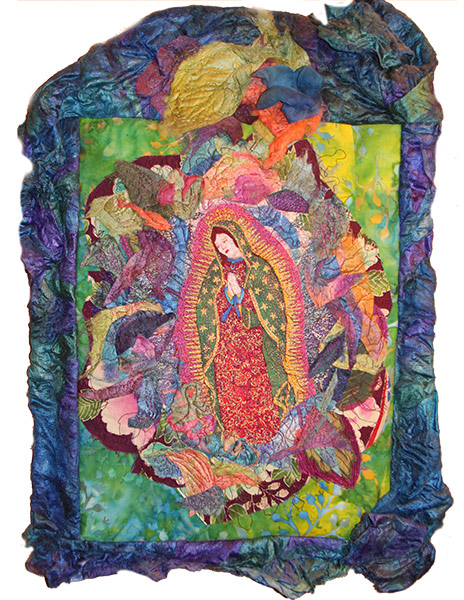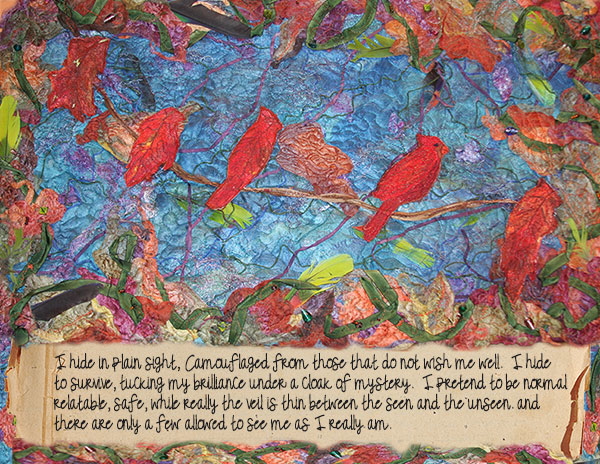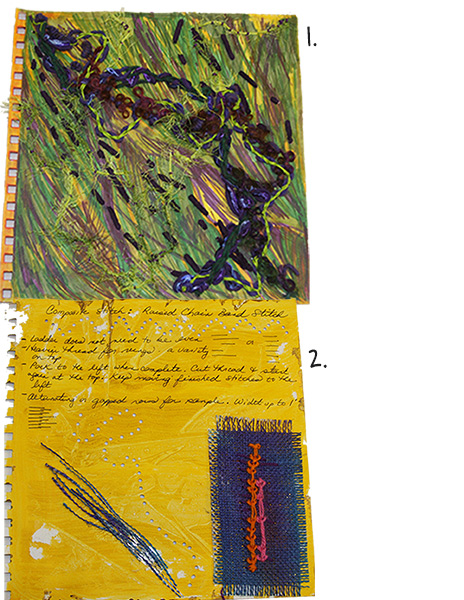Flashback Fridays - Art Travels with Rain: Lesson 3: Thread Painting and Interlacing, Part 1 of 2 September 16 2016, 0 Comments

A few years back we had a feature called "Art Travels with Rain". Rain did a wonderful series on sewing that we are reposting in our Flashback Fridays segments. Please note these may be altered from the original posts to update links, provide information on newer programs, etc.
In case you missed earlier posts in the series:
Art Journaling Sewing Lessons 101
Lesson One: Making Borders and Pockets Using Automatic Machine Stitching
Lesson 2: Using Fusible Interfacings to Attach and Glue Papers and Fabrics
Enjoy!
Lesson 3: Thread Painting and Interlacing, Part 1 of 2
This is one of my all time favorite techniques with a sewing machine or hand stitching…layers of luminescent threads reflecting light just thrills my soul. For the Art Journal and Mixed Media artist, thread painting is a major part of the tool box, and is so rich with possibilities it will take years to fully explore all the options.
First, let’s look at a few of my new Transformation series, inspired by Tangie Baxter’s Symbology workshop (now available as a self-study course). In the workbook, the first three symbols were a bird, a fish, and a butterfly. I am truly amazed at how deeply the workshop exercises have taken my inner process, all from following Tangie’s instructions in the workbook. I would heartily encourage checking out the workshop if you haven’t already done so.
Below is a self-portrait painted on fused silk fibers, then thread painted with various machine threads. Based on the Bird symbol.
This is my vision of my inner dreaming body…the sorceress that lives in a symbolic world.
Title: “An Epiphany of the Moment, a Slice of the Night with Rain”
What is thread painting? It is simply using thread to add color, texture, and line to a shape, a drawing, a printed or painted paper or fabric. In the piece above, I used thread painting techniques to shape my wing with metallic thread, and to define the bird headdress with a mix of metallic and rayon threads. My hair is made up of lines of stitching with several shades of brown and auburn threads. There is space between the lines of free motion machine stitching, so my drawing and painting below shows through, which is one technique. This is the place to start if you are new to machine stitching in free motion. Open stitching is also a good option when sewing on paper as the needle is creating holes in the paper with every stitch, literally perforation.
Some artists thread paint so densely, there is absolutely no base fabric visible. This is labor and materials intensive, but creates a beautiful textured surface, and can look just like a hand embroidered piece with far less work. Look closely at the image below of the “Lady of Guadalupe” which is densely stitched, on top of a commercially printed fabric. This is a great way to alter a commercial fabric to make it “your own”, and add it to your page or collage.
Many quilt artists that make art quilt journal pages use this technique, particularly with printed motifs like art dolls, flowers, houses, vegetables, etc., cutting the element from the background fabric and fusing to a base just like I showed you in Lesson 2 with some of Tangie’s collage pages. Suddenly it doesn’t matter if you feel skilled at drawing and painting in a realistic manner! Simply fuse the motif, then keep stitching free motion as close as possible, or on top of previous stitches until you have the look you want. Changes of thread colors and weights will add to the hand stitched look.
 Title: “Overcoming the Transformation Blues”
Title: “Overcoming the Transformation Blues”
Also part of the series on Transformation inspired by the Symbology project…Thread painted commercial fabric, “Our Lady of Guadalupe”, collage of dyed, printed, stenciled, fused papers, fiber, and fabric, all thread painted. The outer frame is dyed silk brick that I fused with acrylic gloss medium in a shape, then allowed to dry and harden.
If you want to densely stitch paper, fuse it to a backing paper or fabric to help stabilize, and consider using hand stitches on top of the machine stitching without passing the thread through the paper each time. Below are some examples of hand stitching on top of machining on paper from my sketchbook, using a variety of thread and yarn weights. Next week I will explore lacing, pierced paper, and some fabulous tricks for edges on paper.
1. Machine automatic straight stitch with a 5mm basting stitch length, then various weights of threads and yarns chain stitched, looped, overcast, and laced onto the machine stitches without passing through the paper.
2. Burlap threads that have been drawn from the fabric edges, then tack stitched onto the paper on the left bottom. On the right bottom, raised chain band hand stitching on top of horizontal “ladder rungs” made using free motion “beads”: sew in a tight circle, jump horizontally to the side, sew again in a tight circle, forming a rung. This is the same technique I used in Lesson One to attach the Chinese coins to the front of the Symbology Project sketchbook wrap cover, basically sewing in place to anchor, then jump, anchor, back and forth until enough thread has built up to be sturdy for the next step.
Another page of examples of hand stitching on machine stitches, below:
1. Automatic straight stitching in lines and circles, various stitch lengths of 3mm-5mm, than variations on hand Buttonhole stitch using the machine stitches to anchor, while not passing the thread through the paper
2. First I did machine straight stitching at 3mm or longer using a large 110N size needle and a heavy 30 weight thread onto a monoprinted sketchbook page, then added embroidery threads by passing a needle through the previously pierced needle holes. Various weights of threads and yarns were then laced and interlaced through the embellished machine stitches.
3. A page in a book using painted Timtex interfacing as the base, hand interlaced embroidery threads through the machine stitched edges. More about this next week!
Another thread painting option: Creating a densely stitched face or other motif on dissolving stabilizer, netting, tulle, or a lightweight organza, etc, then stitching into your piece. Below is an example of another page in the Transformation series inspired by Tangie’s Symbology Project workshop: Chrysalis. The face is all thread, densely thread painted onto a piece of tulle netting, then stitched onto the background collage.
Title: “Chrysalis”
My piece based on the butterfly symbol, again transformation, the beauty of the butterfly rising out of the pupa, birth out of the Earth, the magic of changing form.
This piece is layered paper, dyed, painted, printed and stenciled fabric, thread painted face, trapped fibers and beads below the netting form the “hair”, fused dyed silk fibers to make paper.
Below: Title: “Camouflage”
A second piece based on the bird symbol and the concept of camouflage…how do I hide to survive? Blend in to flourish? This piece is also about that moment of transformation when energy becomes physical form, and back again, just like the electrons in the zooming shells around the nucleus of an atom, sometimes physical, sometimes just energy. This is my science-geek coming out…I have always been fascinated by the transformation of energy into matter, and the growth and disintegration that can be observed in nature, in our bodies, in all structure and form around us. I am intrigued by rust, by dandelions becoming seed heads and blowing away, by the teeny germination of a pea seed that becomes flowers and food then disintegrates to withered vines. I watch every spring to try and catch that moment of transformation from seed to plant bursting through the soil, but I blink, and miss it again and again. The birds become leaves in the trees in the fall, then suddenly leaf out into form in the spring. Awesome. Just to be alive to witness and feel these moments.
Director Font, thread painting on dyed silk fibers and papers, fused, then stitched. The first symbols of bird, fish, and butterfly have been all about transformation for me, and are inspiring this series.
The red leaves and the “bird” are all densely thread painted onto a piece of silk organza where I had drawn the basic shape in outline with marker, then free motion layered threads in various shades of red and red orange. I added the darker line accents afterwards, and tack-stitched to the background. The “branch” is a rolled piece of dyed silk chiffon, free motion stitched in places to a paper backing.

Journaling: I hide in plain sight, Camouflaged from those that do not wish me well. I hide to survive, tucking my brilliance under a cloak of mystery. I pretend to be normal, relatable, safe, while really the veil is thin between the seen and the unseen and there are only a few allowed to see me as I really am.
Next week, we will continue with Thread painting, piercing, lacing, edges, and look closely at stitching the flower motifs I have been teasing you with for the last two posts. Until then, take care!
Rain
~~~~~
"The Symbology Workshop No. 3"
Please join us next Flashback Friday for another Art Journaling Sewing Lessons installment.
Have a great weekend!
[Posted by: Joy]









